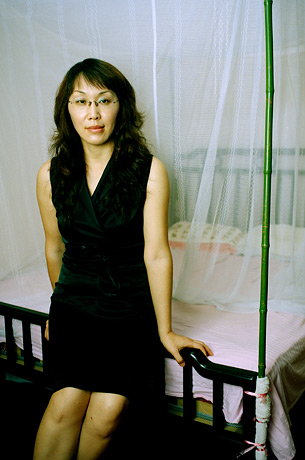
Liu Lichun, age 40, a breast cancer survivor, photographed at home in Shanghai, China.
Six months ago, Liu Lichun didn't know her breast could contain cancer. No one had taught the 40-year-old Chinese woman from Inner Mongolia what the disease was. She'd never heard of a mammogram or mastectomy. It had thus never occurred to her that she would lose her left breast to the mysterious illness nor that such a loss would probably save her life.
The lump that transformed Liu's world was not much larger than a marble. A company physician found it in June during the routine checkup that her employer, a Swiss firm in Shanghai, encouraged its sales staff to undergo each year. Once a biopsy proved the tumor was malignant, Liu believed that the diagnosis was a death sentence. "I'd never heard of anyone in China with cancer who didn't die," she says.
Five years ago, Liu might well have been among them. Breast cancer is the most lethal form of cancer for women in the world. An estimated 1 million cases will be identified this year, and about 500,000 new and existing patients will die from the disease. In the U.S., breast cancer will be diagnosed in 1 in 8 women.
But in China, as in most other emerging economies, breast cancer is a relatively new concern, something that both patients and doctors are only haltingly learning how to treat. Previously a malady that mostly afflicted white, affluent women in the industrial hubs of North America and Western Europe, breast cancer is everywhere. Asia, Africa, Eastern Europe and Latin America have all seen their caseloads spike. By 2020, 70% of all breast-cancer cases worldwide will be in developing countries.
Worse, as the reach of the disease is expanding, the reach of detection and treatment isn't. For a woman battling breast cancer in the industrialized West, new diagnosis and treatment options come along all the time. Not so elsewhere. On Sept. 28 and 29, the U.S.-based breast-cancer advocacy group Susan G. Komen for the Cure convened an international conference of doctors, advocates and survivors in Budapest. The delegates shared stories from more than 30 countries, and the differences among them were stark. In the U.S., an estimated $8.1 billion is spent to diagnose and treat breast cancer each year, and the ubiquity of mammography machines, clinics and specialists shows what that money can buy. In Pune, India, by contrast, home to 3.5 million women, there is just one facility that provides comprehensive breast-cancer services. Half of all Indian women with the disease go entirely without treatment. In South Africa, only 5% of cancers are caught in the earliest phase of the disease, Stage 0 or 1 (out of 4). In the U.S., that figure is 50%. In Ukraine, where mammography machines are available, if not plentiful, a shortage of film requires that doctors choose between taking the recommended two-view image of a patient's breasts and taking a one-view image of twice as many women. As for a desperately poor land like Kenya? If you can't travel overseas for treatment, says Mary Onyango, a resident of the country whose disease was diagnosed at age 40, "you just sit and wait for your death." Says Nancy Brinker, founder of the Komen group: "Poverty is a known carcinogen."
Some of this bad news is the result of very good news. Thanks to better sanitation, more food and improved public health, the average life expectancy in low- and middle-income nations has risen from 50 in 1965 to 65 in 2005. Women are simply living long enough to reach the age at which they're most susceptible to breast cancer. With Westernized life spans, however, can come Western habits too — fatty foods, lack of exercise and obesity, all of which may raise the incidence of breast cancer.
While the risk factors for a disease may cross borders freely, the cultural understanding it takes to treat it doesn't. Americans may live in a world of pink ribbons and LIVESTRONG bracelets, but in other parts of the globe, breast cancer is still a shameful secret. Every three minutes an Egyptian woman is informed that she has the illness, and one of her first fears is that her husband will leave her. Secrecy leads not only to misery but also to misinformation. In India, women with breast cancer may be forced to use separate plates and spoons because of the widespread belief that the disease is contagious. "There's fear to feed the children with her own hands," says Vijaya Mukerjee, a breast-cancer survivor living in Kolkata, formerly Calcutta. Brazilian nurse Gilze Maria Costa Francisco, a breast-cancer survivor herself, recalls a young mother asking her whether she could contract breast cancer if her daughter burped during breast-feeding.
All these local problems and beliefs mean that solutions will have to be similarly regionalized. "Physicians country by country will have to figure out how to beat this cancer," says Dr. Eric Winer, chief scientific adviser to Komen for the Cure. As a TIME investigation in North America, Latin America, Africa, Asia, Europe and the Middle East showed, there are places where those solutions are being found — and places where they aren't. There are countries in which lives are being saved — and others in which far too many are still being lost. In all of them, the first step to beating the disease is understanding how it works.